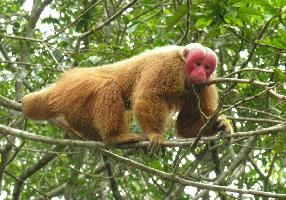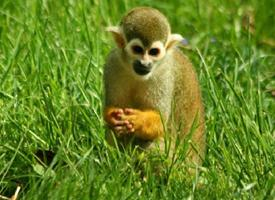
Váhy a míry
| Délka | 57 cm |
|---|---|
| Hmotnost | od 1,5 do 3 kg |
| Délka ocasu | 15 cm |
Biologická data
| Délka života | 20 r |
|---|---|
| Délka březosti | 182 d |
| Počet mláďat | 1 |
Popis zvířete
The Bald Uakari, scientifically known as Cacajao calvus, is a distinctive and somewhat enigmatic species of primate that inhabits the remote and lush rainforests of the Amazon Basin, primarily found in Brazil, Peru, and Colombia. This remarkable animal is most notable for its vivid red face and lack of hair on its head, characteristics that starkly set it apart from other primates and have piqued the curiosity of scientists and wildlife enthusiasts alike.Adult Bald Uakaris are medium-sized monkeys, typically weighing between 2.75 to 3.45 kg (about 6 to 7.6 pounds), with a body length ranging from 45 to 50 cm (about 17.7 to 19.7 inches), not including their relatively short tails which are about 15 to 18 cm (5.9 to 7.1 inches) long. Unlike many other monkeys, their tails are not prehensile, meaning they cannot use them to grasp branches. However, this does not impede their remarkable agility in navigating the dense canopies of their habitat.
The most striking feature of the Bald Uakari is its bright red face, which is completely bald, contrasting sharply with its long, shaggy coat that ranges in color from white to orange-red. Scientists believe that the vibrant color of its face could be an indicator of health, playing a crucial role in social interactions and mate selection. A pale face may indicate ill health and thus, individuals with brighter faces are considered more desirable as mates.
Bald Uakaris are highly social animals, living in large groups that can number up to 100 individuals. These groups are known to split into smaller foraging parties during the day. Their diet primarily consists of seeds, fruits, leaves, and insects, which they skillfully extract from the dense vegetation using their strong jaws and elongated teeth. This diet is crucial not only for their survival but also for the ecosystem they inhabit, as they play a significant role in seed dispersal, contributing to the health and diversity of their rainforest home.
Communication among Bald Uakaris involves a complex system of vocalizations, facial expressions, and body postures. These interactions are essential for maintaining social structure within the group, coordinating activities, and establishing relationships between individuals.
The Bald Uakari faces several threats to its survival, primarily from habitat destruction due to deforestation and human encroachment. Illegal hunting and capture for the pet trade also pose significant risks. As a result, the Bald Uakari is classified as vulnerable by the International Union for Conservation of Nature (IUCN), highlighting the urgent need for conservation efforts to protect these unique primates and their habitat.
Conservation initiatives focus on habitat preservation, anti-poaching measures, and research to better understand the ecological needs and behavior of the Bald Uakari. Efforts to educate local communities about the importance of these primates and their role in the ecosystem are also crucial for ensuring their survival.
In summary, the Bald Uakari is a fascinating and unique primate with distinctive physical traits and behaviors that make it an important subject for scientific study and conservation efforts. Its existence is closely tied to the health of the Amazon rainforest, and its survival depends on our ability to protect this vital ecosystem.
Podobná zvířata
Nové fotografie zvířat
Top 10 zvířat
- Chinese water dragon (Physignathus cocincinus)
- Galápagos tortoise (Geochelone nigra complex)
- Dolphin gull (Leucophaeus scoresbii)
- Japanese macaque (Macaca fuscata)
- Colombian red howler (Alouatta seniculus)
- Sea urchins (Echinoidea)
- Diana monkey (Cercopithecus diana)
- Moustached guenon (Cercopithecus cephus)
- Colossal squid (Mesonychoteuthis hamiltoni)
- Common house mosquito (Culex pipiens)
